bleed FORD KUGA 2011 1.G User Guide
[x] Cancel search | Manufacturer: FORD, Model Year: 2011, Model line: KUGA, Model: FORD KUGA 2011 1.GPages: 2057
Page 1354 of 2057
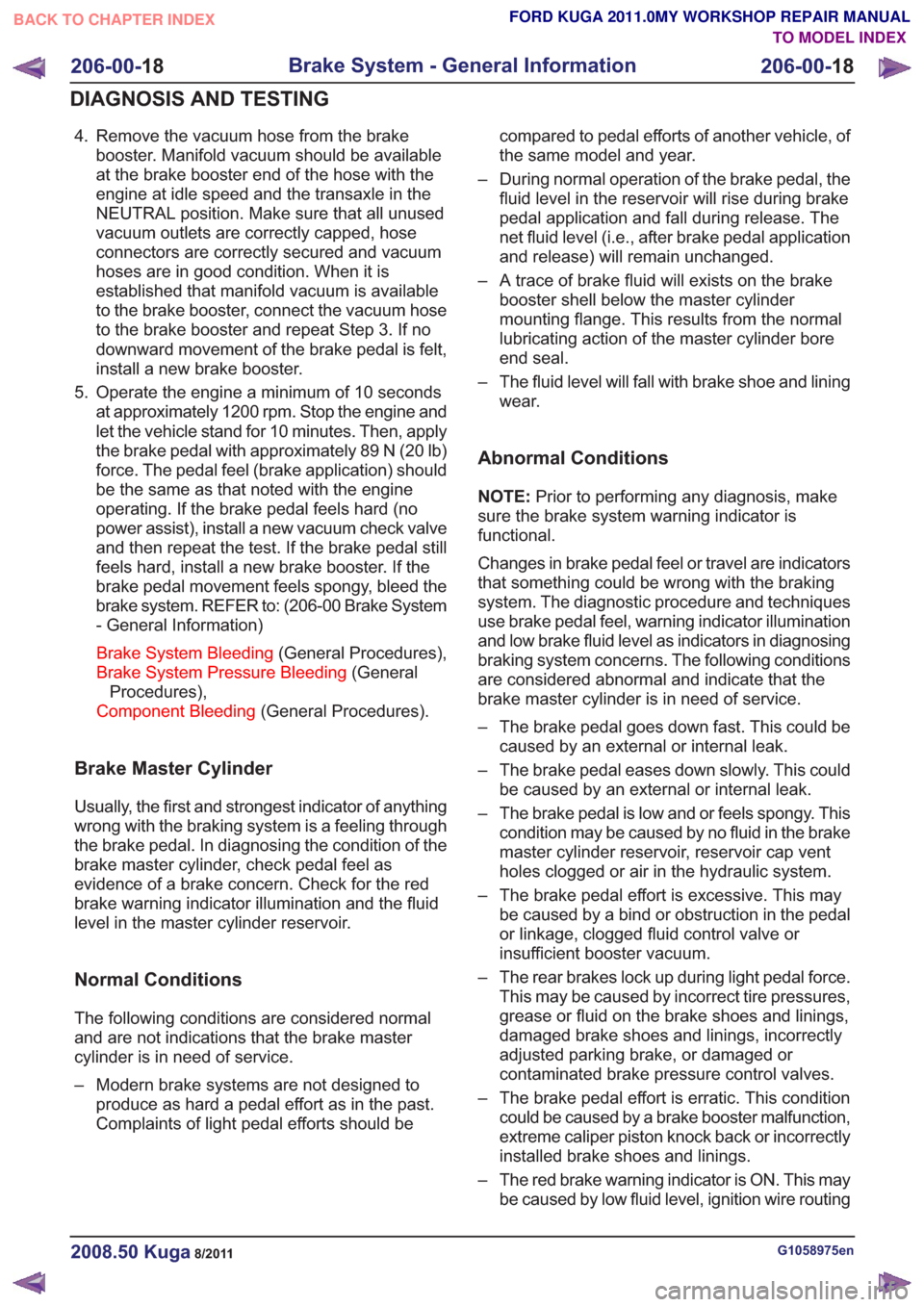
4. Remove the vacuum hose from the brakebooster. Manifold vacuum should be available
at the brake booster end of the hose with the
engine at idle speed and the transaxle in the
NEUTRAL position. Make sure that all unused
vacuum outlets are correctly capped, hose
connectors are correctly secured and vacuum
hoses are in good condition. When it is
established that manifold vacuum is available
to the brake booster, connect the vacuum hose
to the brake booster and repeat Step 3. If no
downward movement of the brake pedal is felt,
install a new brake booster.
5. Operate the engine a minimum of 10 seconds at approximately 1200 rpm. Stop the engine and
let the vehicle stand for 10 minutes. Then, apply
the brake pedal with approximately 89 N (20 lb)
force. The pedal feel (brake application) should
be the same as that noted with the engine
operating. If the brake pedal feels hard (no
power assist), install a new vacuum check valve
and then repeat the test. If the brake pedal still
feels hard, install a new brake booster. If the
brake pedal movement feels spongy, bleed the
brake system. REFER to: (206-00 Brake System
- General Information)
Brake System Bleeding (General Procedures),
Brake System Pressure Bleeding (General
Procedures),
Component Bleeding (General Procedures).
Brake Master Cylinder
Usually, the first and strongest indicator of anything
wrong with the braking system is a feeling through
the brake pedal. In diagnosing the condition of the
brake master cylinder, check pedal feel as
evidence of a brake concern. Check for the red
brake warning indicator illumination and the fluid
level in the master cylinder reservoir.
Normal Conditions
The following conditions are considered normal
and are not indications that the brake master
cylinder is in need of service.
– Modern brake systems are not designed to
produce as hard a pedal effort as in the past.
Complaints of light pedal efforts should be compared to pedal efforts of another vehicle, of
the same model and year.
– During normal operation of the brake pedal, the fluid level in the reservoir will rise during brake
pedal application and fall during release. The
net fluid level (i.e., after brake pedal application
and release) will remain unchanged.
– A trace of brake fluid will exists on the brake booster shell below the master cylinder
mounting flange. This results from the normal
lubricating action of the master cylinder bore
end seal.
– The fluid level will fall with brake shoe and lining wear.
Abnormal Conditions
NOTE: Prior to performing any diagnosis, make
sure the brake system warning indicator is
functional.
Changes in brake pedal feel or travel are indicators
that something could be wrong with the braking
system. The diagnostic procedure and techniques
use brake pedal feel, warning indicator illumination
and low brake fluid level as indicators in diagnosing
braking system concerns. The following conditions
are considered abnormal and indicate that the
brake master cylinder is in need of service.
– The brake pedal goes down fast. This could be caused by an external or internal leak.
– The brake pedal eases down slowly. This could be caused by an external or internal leak.
– The brake pedal is low and or feels spongy. This condition may be caused by no fluid in the brake
master cylinder reservoir, reservoir cap vent
holes clogged or air in the hydraulic system.
– The brake pedal effort is excessive. This may be caused by a bind or obstruction in the pedal
or linkage, clogged fluid control valve or
insufficient booster vacuum.
– The rear brakes lock up during light pedal force. This may be caused by incorrect tire pressures,
grease or fluid on the brake shoes and linings,
damaged brake shoes and linings, incorrectly
adjusted parking brake, or damaged or
contaminated brake pressure control valves.
– The brake pedal effort is erratic. This condition could be caused by a brake booster malfunction,
extreme caliper piston knock back or incorrectly
installed brake shoes and linings.
– The red brake warning indicator is ON. This may be caused by low fluid level, ignition wire routing
G1058975en2008.50 Kuga8/2011
206-00- 18
Brake System - General Information
206-00- 18
DIAGNOSIS AND TESTING
TO MODEL INDEX
BACK TO CHAPTER INDEX
FORD KUGA 2011.0MY WORKSHOP REPAIR MANUAL
Page 1358 of 2057
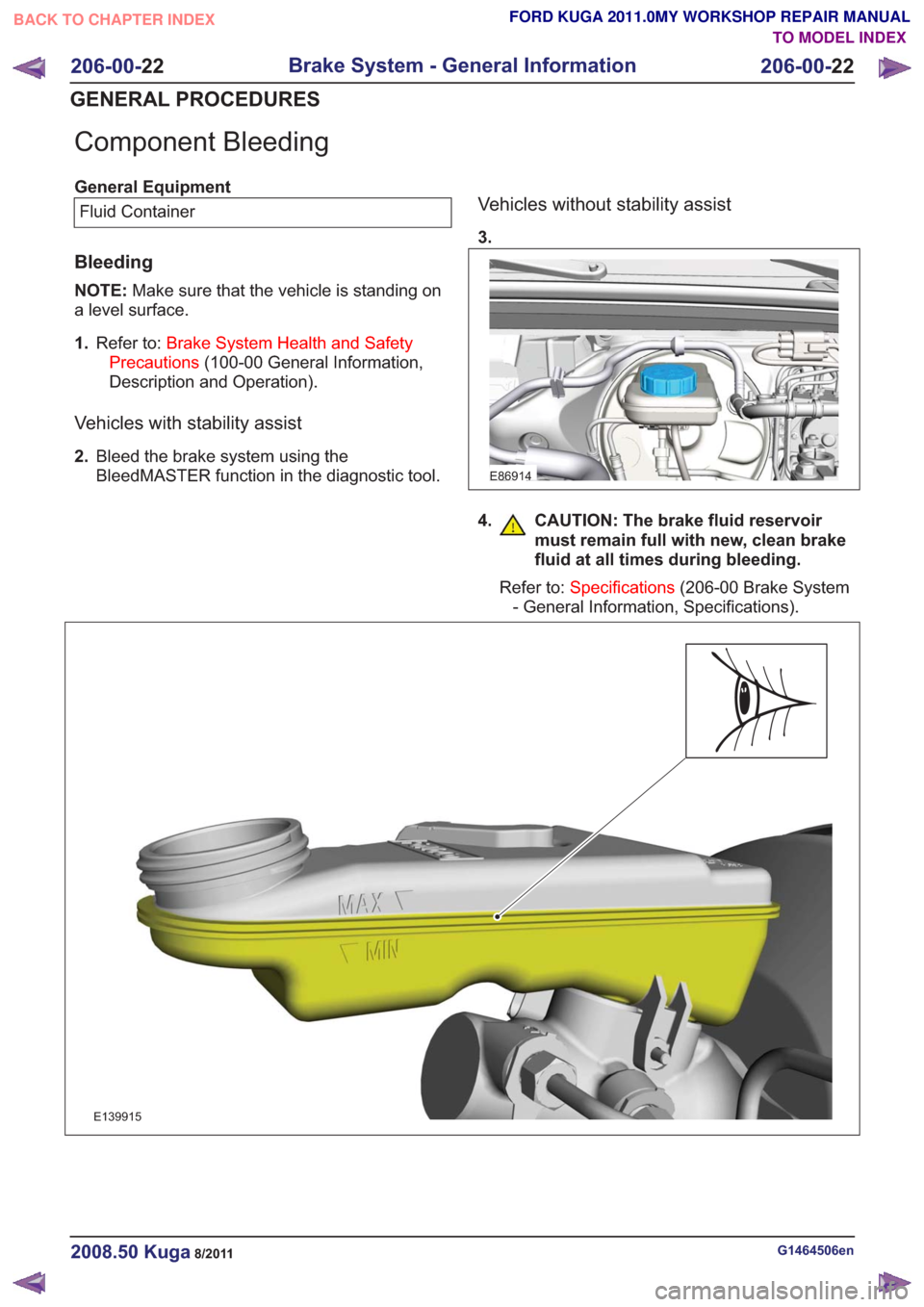
Component Bleeding
General EquipmentFluid Container
Bleeding
NOTE: Make sure that the vehicle is standing on
a level surface.
1. Refer to: Brake System Health and Safety
Precautions (100-00 General Information,
Description and Operation).
Vehicles with stability assist
2. Bleed the brake system using the
BleedMASTER function in the diagnostic tool.
Vehicles without stability assist
3.
E86914
4. CAUTION: The brake fluid reservoir
must remain full with new, clean brake
fluid at all times during bleeding.
Refer to: Specifications (206-00 Brake System
- General Information, Specifications).
E139915
G1464506en2008.50 Kuga8/2011
206-00- 22
Brake System - General Information
206-00- 22
GENERAL PROCEDURES
TO MODEL INDEX
BACK TO CHAPTER INDEX
FORD KUGA 2011.0MY WORKSHOP REPAIR MANUAL
Page 1360 of 2057

E139456
8.Operate the brake pedal fully (pumping brake
fluid and air into the bleed jar) and allow the
brake pedal to return to the rest position. 9.
Continue operating the brake pedal until air-free
fluid is being pumped into the bleed jar.
10. Refer to: Specifications (206-00 Brake System
- General Information, Specifications).
G1464506en2008.50 Kuga8/2011
206-00- 24
Brake System - General Information
206-00- 24
GENERAL PROCEDURES
TO MODEL INDEX
BACK TO CHAPTER INDEX
FORD KUGA 2011.0MY WORKSHOP REPAIR MANUAL
Page 1361 of 2057
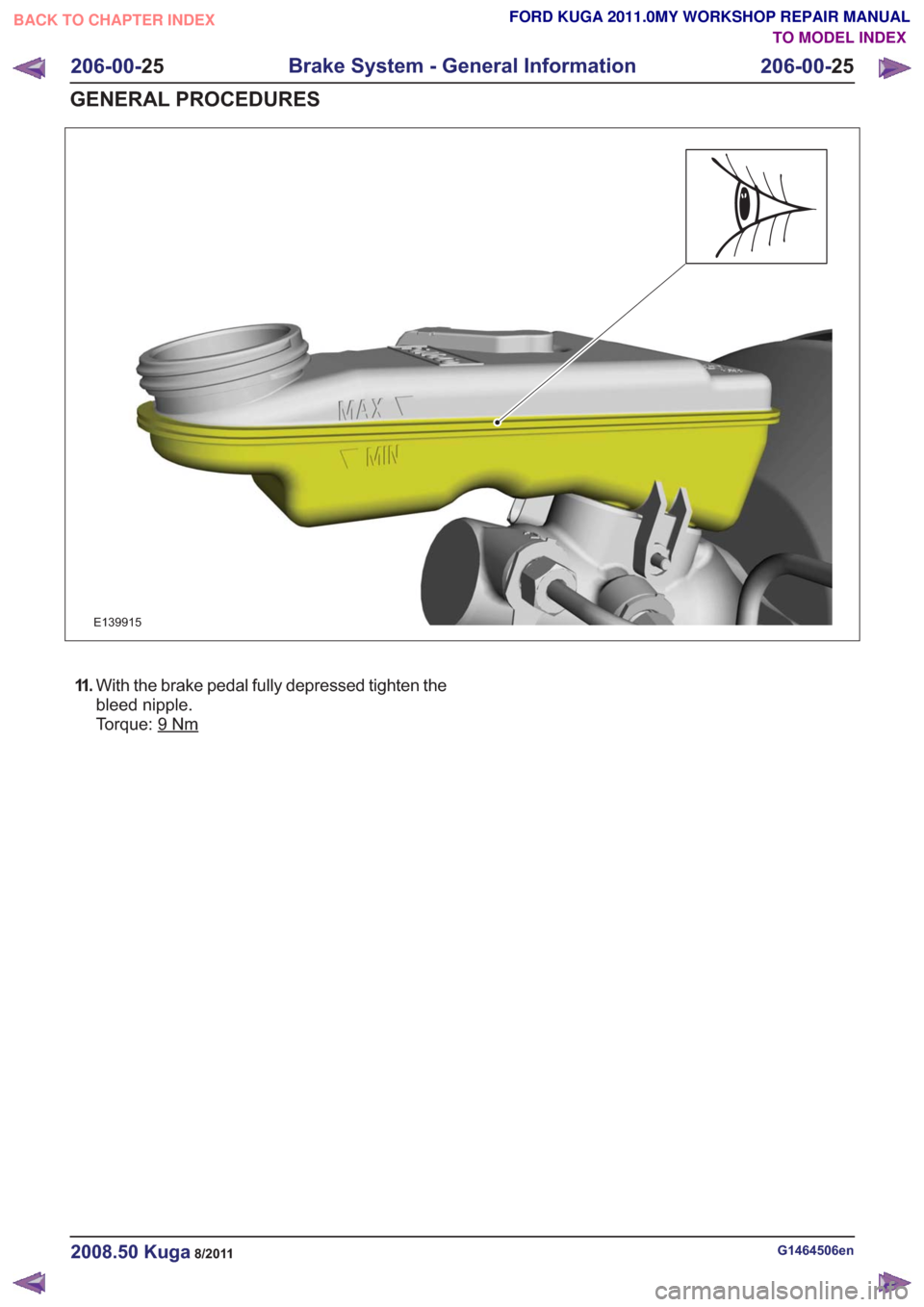
E139915
11 .With the brake pedal fully depressed tighten the
bleed nipple.
Torque: 9
Nm
G1464506en2008.50 Kuga8/2011
206-00- 25
Brake System - General Information
206-00- 25
GENERAL PROCEDURES
TO MODEL INDEX
BACK TO CHAPTER INDEX
FORD KUGA 2011.0MY WORKSHOP REPAIR MANUAL
Page 1363 of 2057
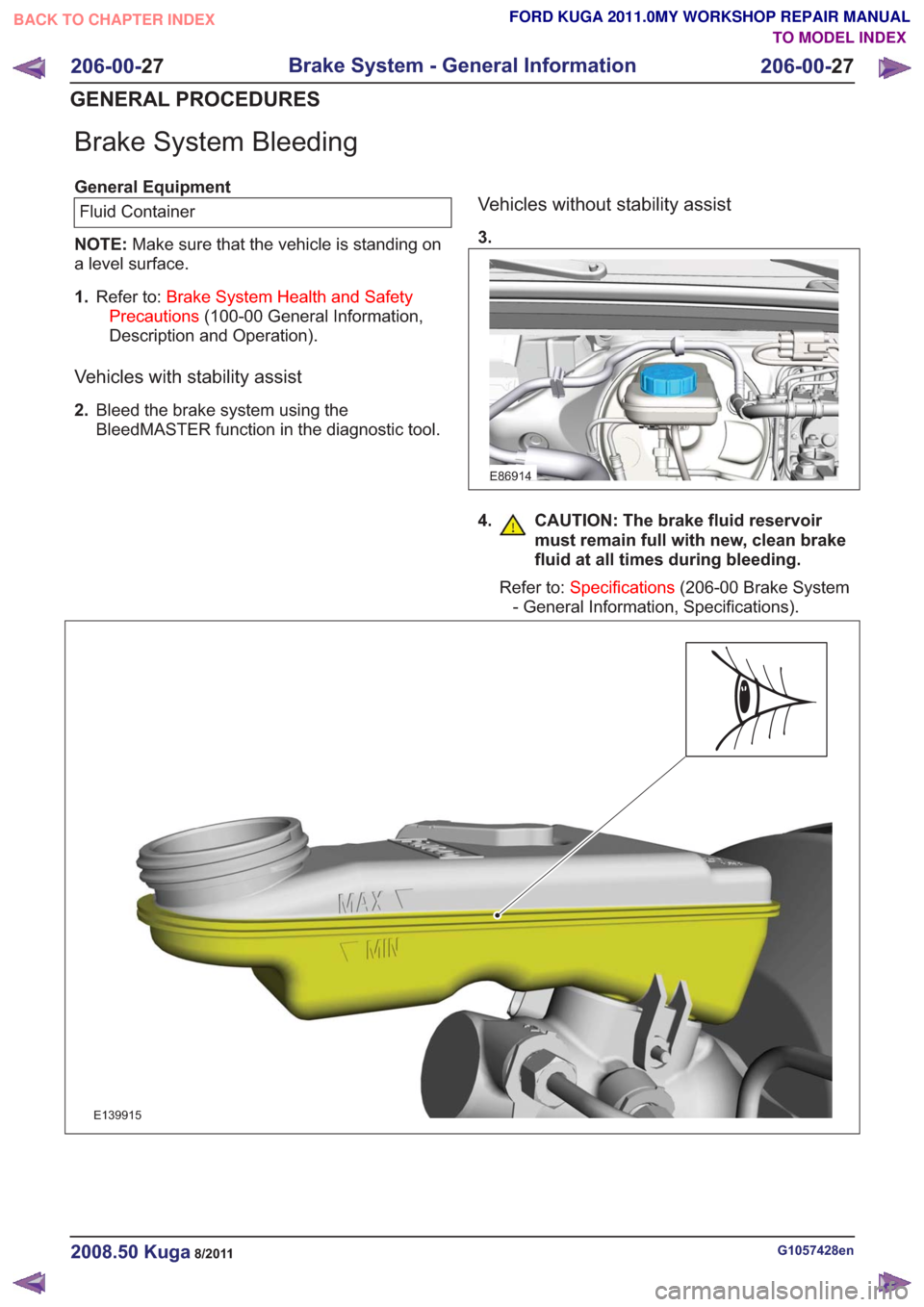
Brake System Bleeding
General EquipmentFluid Container
NOTE: Make sure that the vehicle is standing on
a level surface.
1. Refer to: Brake System Health and Safety
Precautions (100-00 General Information,
Description and Operation).
Vehicles with stability assist
2. Bleed the brake system using the
BleedMASTER function in the diagnostic tool.
Vehicles without stability assist
3.
E86914
4. CAUTION: The brake fluid reservoir
must remain full with new, clean brake
fluid at all times during bleeding.
Refer to: Specifications (206-00 Brake System
- General Information, Specifications).
E139915
G1057428en2008.50 Kuga8/2011
206-00- 27
Brake System - General Information
206-00- 27
GENERAL PROCEDURES
TO MODEL INDEX
BACK TO CHAPTER INDEX
FORD KUGA 2011.0MY WORKSHOP REPAIR MANUAL
Page 1365 of 2057
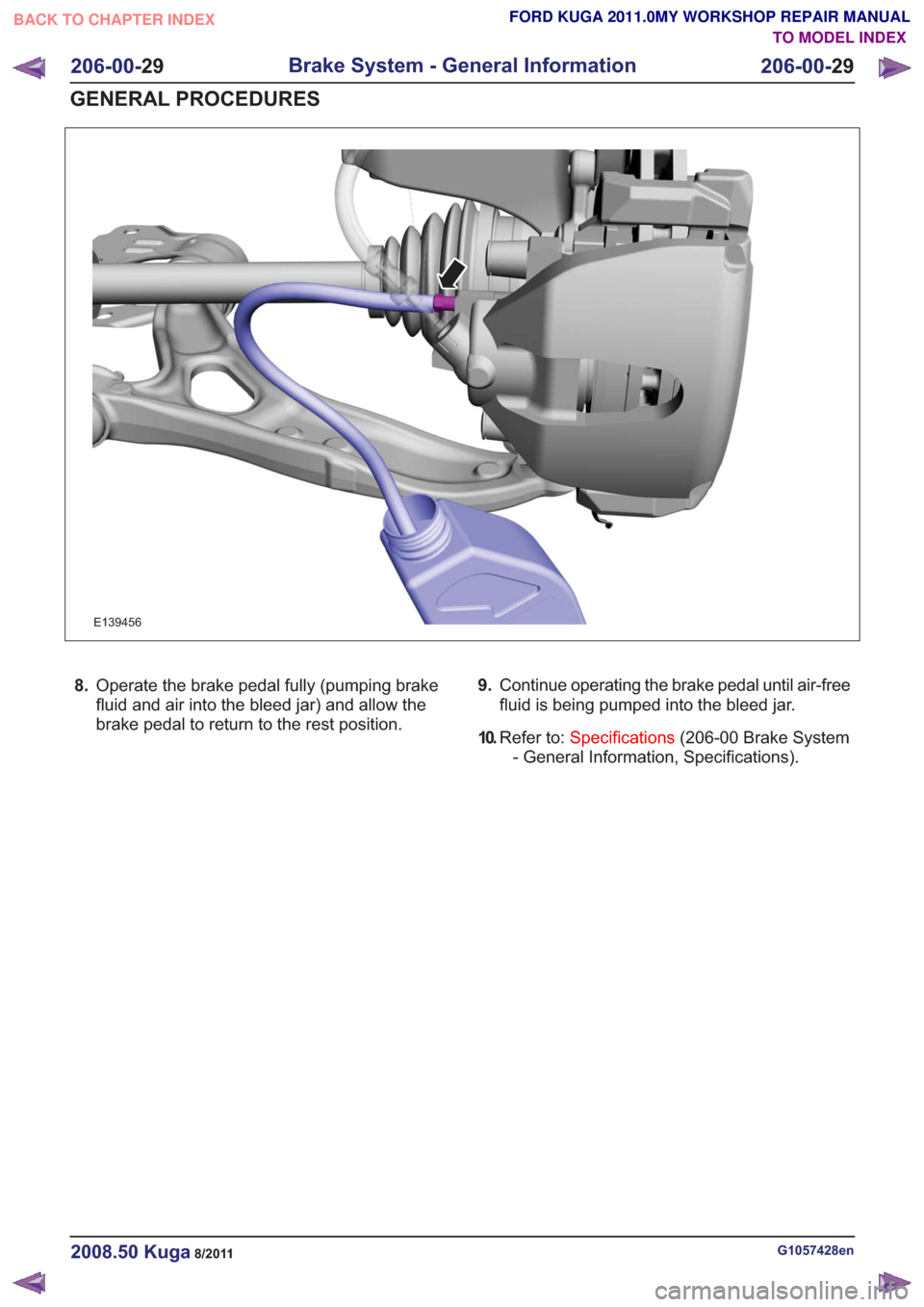
E139456
8.Operate the brake pedal fully (pumping brake
fluid and air into the bleed jar) and allow the
brake pedal to return to the rest position. 9.
Continue operating the brake pedal until air-free
fluid is being pumped into the bleed jar.
10. Refer to: Specifications (206-00 Brake System
- General Information, Specifications).
G1057428en2008.50 Kuga8/2011
206-00- 29
Brake System - General Information
206-00- 29
GENERAL PROCEDURES
TO MODEL INDEX
BACK TO CHAPTER INDEX
FORD KUGA 2011.0MY WORKSHOP REPAIR MANUAL
Page 1366 of 2057
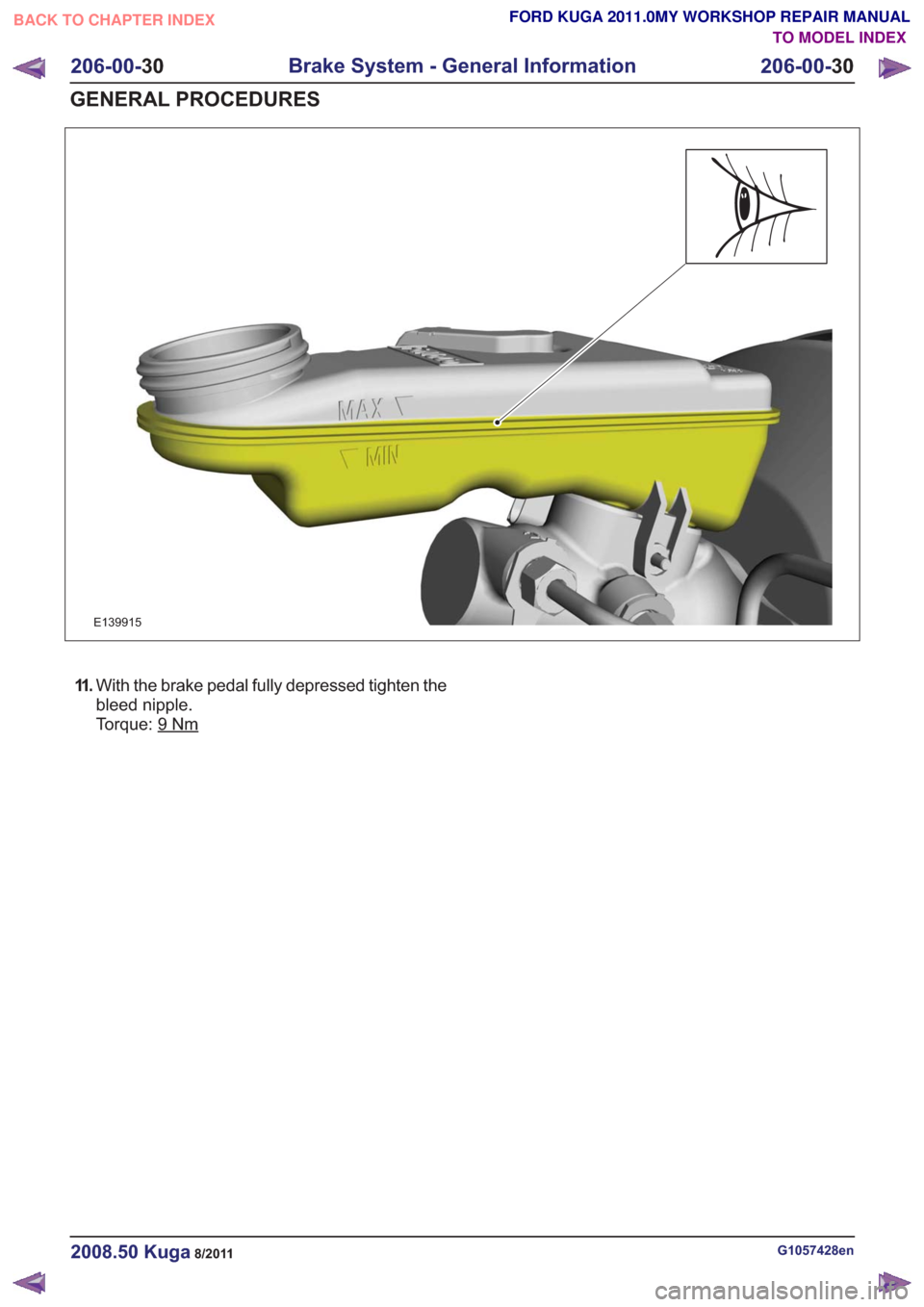
E139915
11 .With the brake pedal fully depressed tighten the
bleed nipple.
Torque: 9
Nm
G1057428en2008.50 Kuga8/2011
206-00- 30
Brake System - General Information
206-00- 30
GENERAL PROCEDURES
TO MODEL INDEX
BACK TO CHAPTER INDEX
FORD KUGA 2011.0MY WORKSHOP REPAIR MANUAL
Page 1370 of 2057
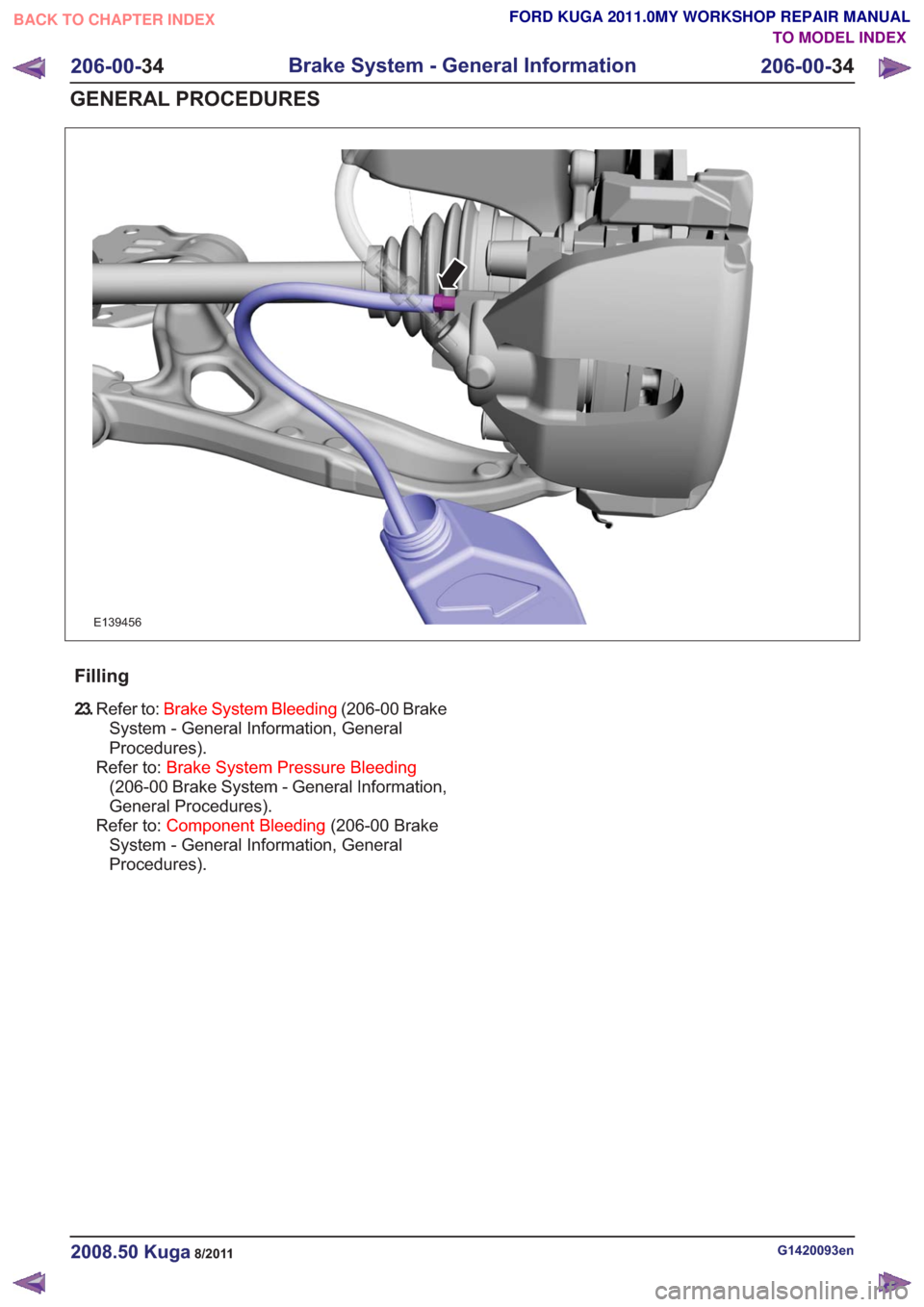
E139456
Filling
23.Refer to: Brake System Bleeding (206-00 Brake
System - General Information, General
Procedures).
Refer to: Brake System Pressure Bleeding
(206-00 Brake System - General Information,
General Procedures).
Refer to: Component Bleeding (206-00 Brake
System - General Information, General
Procedures).
G1420093en2008.50 Kuga8/2011
206-00- 34
Brake System - General Information
206-00- 34
GENERAL PROCEDURES
TO MODEL INDEX
BACK TO CHAPTER INDEX
FORD KUGA 2011.0MY WORKSHOP REPAIR MANUAL
Page 1371 of 2057
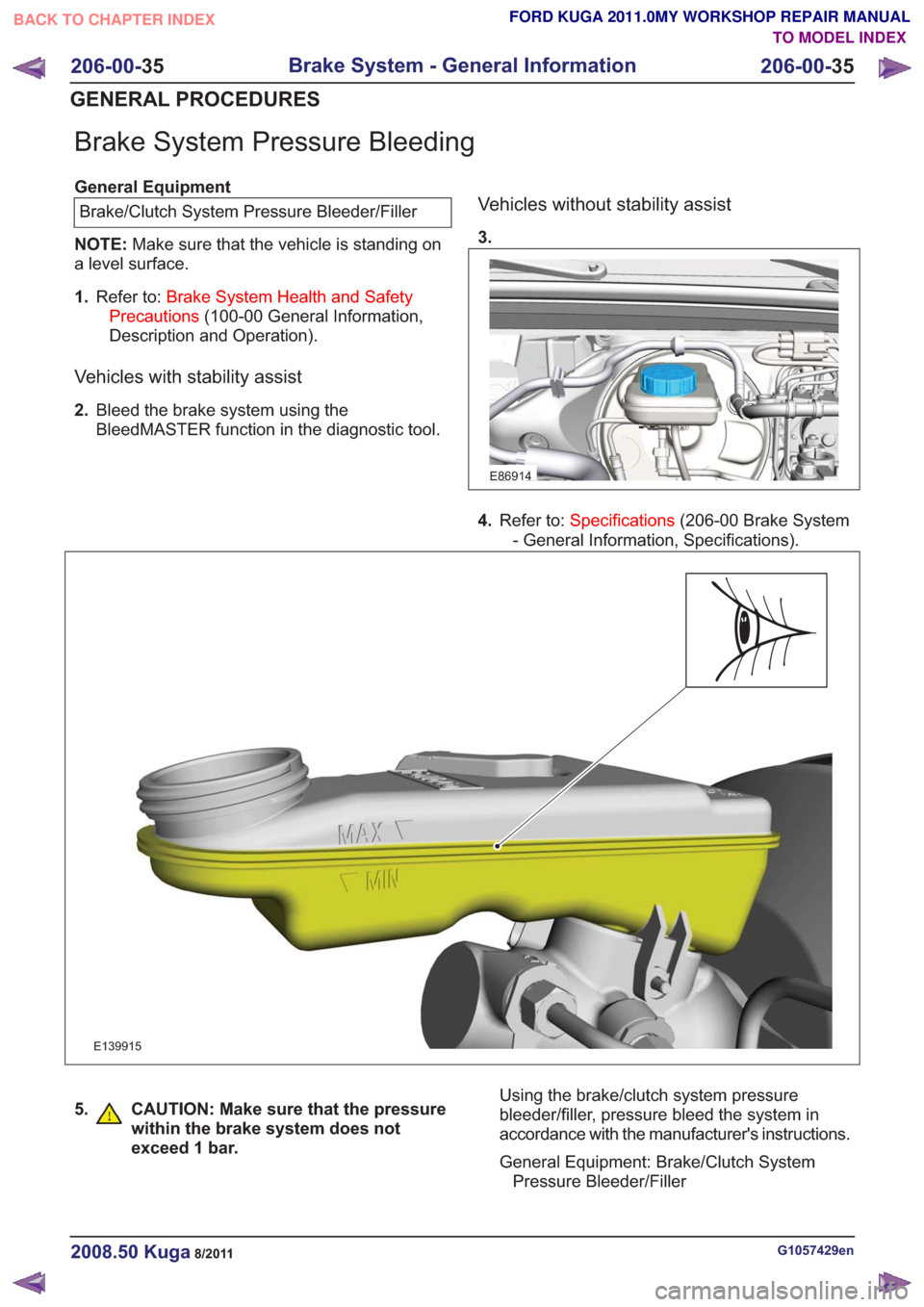
Brake System Pressure Bleeding
General EquipmentBrake/Clutch System Pressure Bleeder/Filler
NOTE: Make sure that the vehicle is standing on
a level surface.
1. Refer to: Brake System Health and Safety
Precautions (100-00 General Information,
Description and Operation).
Vehicles with stability assist
2. Bleed the brake system using the
BleedMASTER function in the diagnostic tool.
Vehicles without stability assist
3.
E86914
4.Refer to: Specifications (206-00 Brake System
- General Information, Specifications).
E139915
5. CAUTION: Make sure that the pressure within the brake system does not
exceed 1 bar.Using the brake/clutch system pressure
bleeder/filler, pressure bleed the system in
accordance with the manufacturer's instructions.
General Equipment: Brake/Clutch SystemPressure Bleeder/Filler
G1057429en2008.50 Kuga8/2011
206-00- 35
Brake System - General Information
206-00- 35
GENERAL PROCEDURES
TO MODEL INDEX
BACK TO CHAPTER INDEX
FORD KUGA 2011.0MY WORKSHOP REPAIR MANUAL
Page 1376 of 2057
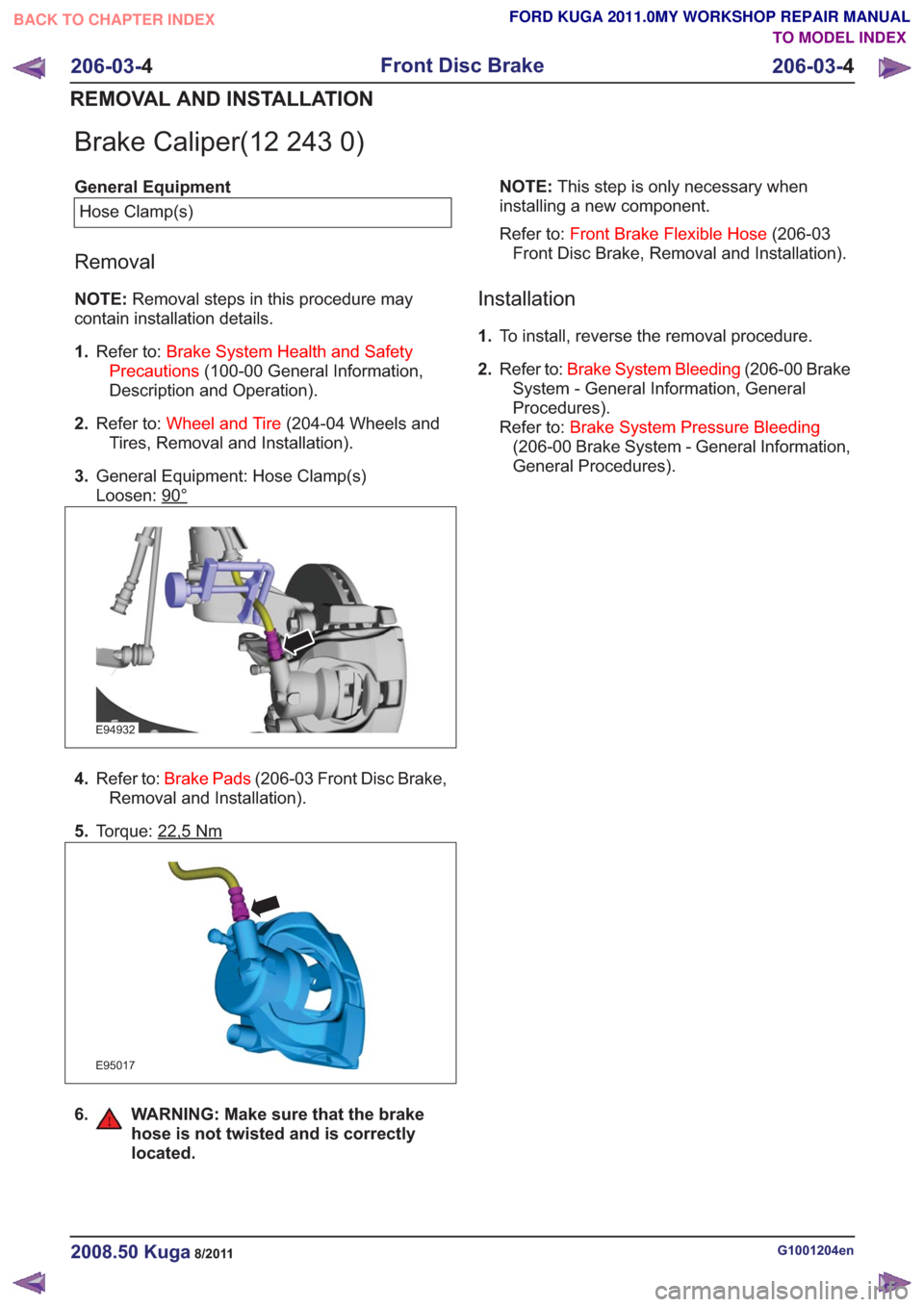
Brake Caliper(12 243 0)
General EquipmentHose Clamp(s)
Removal
NOTE: Removal steps in this procedure may
contain installation details.
1. Refer to: Brake System Health and Safety
Precautions (100-00 General Information,
Description and Operation).
2. Refer to: Wheel and Tire (204-04 Wheels and
Tires, Removal and Installation).
3. General Equipment: Hose Clamp(s)
Loosen: 90°
E94932
4.Refer to: Brake Pads (206-03 Front Disc Brake,
Removal and Installation).
5. Torque: 22,5
Nm
E95017
6. WARNING: Make sure that the brake
hose is not twisted and is correctly
located.
NOTE: This step is only necessary when
installing a new component.
Refer to: Front Brake Flexible Hose (206-03
Front Disc Brake, Removal and Installation).
Installation
1. To install, reverse the removal procedure.
2. Refer to: Brake System Bleeding (206-00 Brake
System - General Information, General
Procedures).
Refer to: Brake System Pressure Bleeding
(206-00 Brake System - General Information,
General Procedures).
G1001204en2008.50 Kuga8/2011
206-03- 4
Front Disc Brake
206-03- 4
REMOVAL AND INSTALLATION
TO MODEL INDEX
BACK TO CHAPTER INDEX
FORD KUGA 2011.0MY WORKSHOP REPAIR MANUAL